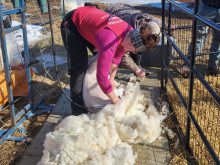RED DEER – A healthy range provides grazing flexibility.
For those grazing forest reserves, keeping the grass healthy is just one of many challenges, said Mike Alexander of the Alberta Land and Forest Service, which is responsible for short-term grazing leases.
“When we’re looking at forest grazing, we’re actually looking at a mosaic,” said Alexander during a meeting of the Society for Range Management, an international group concerned with grazing and conservation.
Forest grazing takes place in range improvement areas, meadows, aspen and conifer forests, and forestry cut blocks and cut lines. Each area has a variety of plant communities that have variable value to the livestock, depending on time of year.
Read Also

Charges laid after cattle theft
Saskatchewan RCMP lay two charges against a man after six cattle went missing.
Distance from water is often the greatest restriction in these areas, because cattle will not travel long distances to drink and cannot cross muskeg or dense forest.
“The first thing to go is the water, not the forage,” Alexander said.
“When the water disappears, that’s your biggest management problem.”
Dugout location is important and a solar pump can be a good investment because it delivers clean water to animals rather than encouraging them to trample river and creek banks. When the water is clean, cattle will have a drink and leave.
But when water is poorly managed, they prefer to stay close. Eventually the area is battered and plant life disappears. Water quality then deteriorates.
Forest encroachment is another challenge. Overgrown areas limit the amount of available grassland for domestic livestock and wildlife. Roving bison herds and fire used to keep the forest back and under control. Prescribed burning can work to clear some of the undesirable undergrowth and open up the forest canopy for improved grazing.
While there are a wide variety of plants in forested areas, poisonous plants like larkspur pose a serious problem.
“There are times when it would be great to graze, but because of the larkspur, you can’t,” Alexander said.
“Noxious weeds are one of the greatest threats to sustainable systems in this area.”
Predators such as coyotes and wolves are a big problem in forest grazing. Their presence at certain times of the year may restrict the times cattle are released. Wolves often use calves to train their pups how to hunt.
There are also other ways to make forest grazing work:
- Fence off portions of the range to manage grazing distribution. Try rotational systems throughout the year to take advantage of the variety of plants available during the season.
- Salting can help move animals around. However, it is important to consider the sites where salt blocks or loose mineral are provided because it can leach into the soil.
- Riding with the herd is also a good way to move animals about the range to desired spots. It also gives an indication of how well the group is doing and helps the producer study individual cows and their behaviour. Later management decisions such as culling are easier with this background knowledge.

















